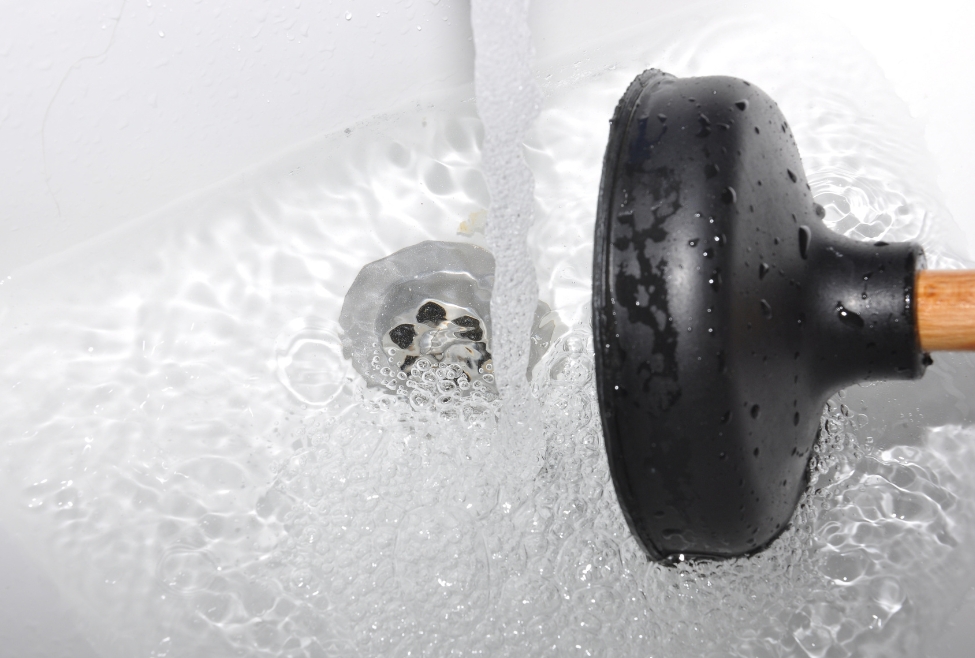Listed here in the next paragraphs you can get some superb help and advice relating to Solved! How to Fix a Slow Sink Drain.

Introduction
We've all existed: You're cleaning your teeth or washing your hands, and you discover the water pooling in the sink. As opposed to rapidly swirling down the drain, it sticks around, turning your once-refreshing early morning regimen into a miniature swamp scene. A slow-draining sink isn't just annoying; it's often an indicator of larger plumbing issues prowling underneath the surface. Fortunately is that most slow-draining sinks can be taken care of with a little knowledge, a couple of fundamental tools, and some perseverance. All set to tackle this job head-on? Allow's roll up our sleeves and dive right in.
Comprehending the Sources Of a Slow-Draining Sink
Prior to you start poking around in your pipelines, it assists to recognize what might be triggering the slowdown. Comprehending the origin makes it much easier to select the appropriate repair.
Tools and Products You'll Need
The right devices make all the distinction. Thankfully, you won't require a totally stocked plumbing technician's van to get the job done.
Step-by-Step Overview to Taking Care Of a Slow-Draining Sink
Now, allow's enter the nitty-gritty. This detailed procedure will guide you via straightforward methods to restore your sink's water drainage.
Action 1: Get Rid Of and Clean the Stopper
Often, the stopper (that small plug you push down to block water) is the first perpetrator. Remove it meticulously and clean off any type of hair or crud trapped around its base. Rinse it extensively prior to placing it back in position.
Action 2: Make Use Of a Bettor to Displace Particles
Got that plunger ready? Placement it over the drain and provide it a couple of firm pumps. The idea is to develop suction that can loosen any blockage. If you see little bits of particles drifting up, you get on the appropriate track.
Step 3: Attempt a Drainpipe Snake or Cord Hanger
If the plunger doesn't suffice, it's time to draw out the drainpipe serpent. Carefully feed it into the drainpipe and twist as you go. You could really feel some resistance-- that's most likely the obstruction. Keep twisting and pulling till you eliminate the obstruction. If you don't have a drain snake, a corrected the alignment of cable hanger can operate in a pinch.
Step 4: Apply a Do It Yourself Drainpipe Cleaner
An all-natural cleaner made from baking soft drink and vinegar can break down residual crud. Pour half a mug of baking soft drink right into the drain, followed by half a cup of vinegar. Let it fizz for around 15 mins, then flush with warm water. This chain reaction frequently does marvels for small obstructions.
Tip 5: Reconstruct and Check the Sink
Placed everything back together and run the faucet. Does the water now swirl down the drain at a commendable rate? If yes, give on your own a pat on the back. If not, do not misery-- there are still a couple of more tricks up your sleeve.
Essential Tools for DIY Services
A bettor is your go-to beginning point. A small, sink-sized bettor produces suction that can displace minor clogs. For even more relentless blockages, a drainpipe snake (often called a plumber's auger) functions marvels. A pair of handwear covers, a flashlight, and maybe a pair of safety safety glasses are additionally helpful.
Suggested Cleaning Solutions
Mild recipe soap and warm water can help break down greasy accumulation. A blend of baking soft drink and vinegar is a reliable natural home remedy, and enzymatic cleaners supply a more environment-friendly method. Maintain chemical drainpipe cleansers as a last hope, as they can be harsh on your pipes.
Usual Offenders Behind Slow Drainage
So, what's blocking things up? Commonly, it's a combination of day-to-day particles-- assume hair, soap residue, tooth paste residue, and leftover food particles. Over time, these tiny bits gather and hold on to the pipe wall surfaces, gradually narrowing the flow and making it harder for water to travel through. In some cases, mineral deposits from hard water can also include in the substance, developing the perfect tornado for stubborn blockages.
When is it Time to Take Action?
If you notice the water draining pipes slower than common, it's a good concept to interfere earlier as opposed to later on. Waiting as well long can lead to complete clogs, undesirable odors, and even pipeline damage. If the water takes greater than a few seconds to clean out after switching off the faucet, consider it a red flag and prepare yourself to put on your DIY hat.
Security First: Preventative Measures and Preparations
Prior to you launch into unclogging setting, think of security. You're handling possibly filthy water and debris, so slip on a pair of gloves. If you're utilizing chemical cleansers, guarantee the room is well-ventilated and follow the directions on the label.
Protective Equipment and Work Space Arrangement
Set some old towels or rags around the sink area to catch splashes. Clear away any type of items that could get in your method, like soap dispensers or tooth brush owners. Ensure you have excellent illumination-- get hold of a flashlight if required.
Alternate Methods for Stubborn Clogs
Not all obstructions are created equivalent. If your sink still rejects to coordinate, consider these different options.
Sodium Bicarbonate and Vinegar Technique
We currently discussed this, yet it deserves keeping in mind once more. This mild, environment-friendly approach is more secure than chemical cleansers and usually fairly efficient.
Chemical Drainpipe Cleansers
Enzyme-based cleansers make use of all-natural bacteria to digest organic matter. They're an exceptional selection if you're aiming to stay clear of rough chemicals. Just keep in mind, they may take a bit longer to work their magic.
Chemical Drainpipe Cleaning Company: Pros and Cons
Chemical cleaners can blast via hard clogs quickly, however they're not without disadvantages. They can produce warm and fumes, damage pipelines if used exceedingly, and position environmental threats. Use them moderately, and constantly comply with the directions very carefully.
Safety Nets to Keep Your Sink Flowing
Prevention is the best remedy. By embracing a few straightforward habits, you can keep your sink from decreasing in the first place.
Regular Cleansing Habits
Clean down the sink container and component location frequently. Remove hair or food bits prior to they have a possibility to wash down the drainpipe.
Preventing Damaging Materials Down the Drain
Hesitate prior to discarding coffee premises, oil, or fibrous vegetable scraps down the sink. These offenders hold on to pipeline walls, developing obstructions gradually.
Regular Upkeep Checks
Set up a quick month-to-month evaluation. Run hot water with the sink for a few mins, focusing on the flow. If it appears slow-moving, act quick prior to it comes to be a full-blown clog.
When to Call a Professional Plumbing Professional
In some cases, regardless of exactly how tough you attempt, that clog simply won't budge. That's when it's time to bring in the pros.
Indications That Indicate a Much More Serious Problem
If your sink drains slowly in spite of several attempts, or if you see water supporting in other components (like your shower or commode), you may have a more major pipes problem prowling much deeper in the system.
Stabilizing DIY Initiatives with Expert Help
While DIY can save you money and provide a feeling of accomplishment, there's no embarassment in calling a specialist. A specialist plumber can analyze your whole pipes configuration, ensuring there's no underlying damage or long-term issue that can cost you extra down the road.
Comparing Costs and Long-Term Solutions
Before deciding, consider the big picture. A low-cost, quick fix might fix the issue momentarily, yet investing in a more permanent remedy might save you money and tension in the long run.
Evaluating the Expenditures of Do It Yourself vs. Expert Fixes
Do it yourself fixes typically set you back bit more than the rate of a plunger or a bottle of cooking soft drink. Expert services, on the other hand, featured a price tag but may avoid repetitive issues and pricey repair work later.
Purchasing Top Quality Fixtures and Upgrades
If your sink's design contributes to regular blockages, it might be worth updating to higher-quality components or modifying the pipes design. Consider this an investment in your house's functionality and comfort.
Verdict
A slow-draining sink can seem like a minor inflammation, but it's commonly an indicator that your pipes requires a little tender loving care. By comprehending the root causes, utilizing the right tools and methods, and devoting to simple preventive measures, you can keep your sink moving openly. And when all else stops working, never ever wait to hire a specialist-- your home's pipes is worth the investment in treatment and maintenance.
7 Ways To Fix A Slow-Draining Sink Before You Call A Plumber
Boiling Water and Baking Soda
Boiling water is sometimes effective enough to breakdown small clogs from items like hair or small food bits. Mix it with baking soda and small clogs should dissolve after a few minutes.
Start by boiling a pot of hot water on your stove and pouring it slowly down your drain to loosen up the hair, food, or other debris. Then, pour a cup of baking down the drain and let it sit for at least ten minutes. While the baking soda is sitting, bring another pot of baking soda to a boil and slowly pour it back down the drain once the ten minutes are up.
You might have to repeat this method more than once to fully break up your sink clog.
Vinegar and Baking Soda
For soap scum or grease clogs, we highly recommend adding vinegar to the solution. When these two ingredients mix, a powerful reaction occurs that creates carbon dioxide which helps to break through whatever is clogging your drain. This option is wonderful if you want to make your own drain cleaner without using a store-bought one that contains harsh chemicals.
The key for this method to work properly is to pour the solution immediately down the drain. Mix together 1/3 cup of both vinegar and baking soda in a bowl before pouring down your sink and letting the solution sit for an hour before rinsing with hot water.
Drain Zip Tool
Insert the zip it tool all the way down your drain. The only part that should be sticking out is the handle. Twist and move the zip tool in the sink to collect as much hair or debris as possible. Begin pulling the zip tool back out of the drain slowly. If it feels hard to pull out, then that means you've collected a lot of junk (which is good). Keep pulling at the zip tool until it's completely out of the drain. When the zip tool is out, immediately discard any hair or debris on the zip tool in a plastic bag. Repeat the process until your sink is unclogged. Clean the Stopper
Clear out items from underneath your sink. You will need to work around the pipes underneath to remove your stopper, so it's important to clear the area so you have room to move. There should be a horizontal rod underneath your sink that's connected to the strap. Remove the rod but make sure you remember what hole rod was in to install it back correctly later on. At the end of where your horizontal rod was should be a pivot nut that is attached to the sink drain. Go ahead and slide a bucket underneath the plumbing since you're going to unscrew the pivot nut and water may leak. You should be able to unscrew the pivot nut by hand, but if it's stubborn, you will need to use a wrench. With the horizontal rod and pivot nut removed, you should be able to remove your sink stopper. Pull it out and clean off the hair and dirt before cleaning the entire stopper with hot water, soap, and vinegar. The last step is to reassemble your parts. Put the stopper back in the sink before re-screwing the pivot nut, horizontal rod, and sliding your under sink items back into place. Plunge the Sink
One of the best way to unclog a slow-draining sink? With the help of a good ole plunger. This effective DIY method for unclogging a sink work the same way you'd plunge a toilet, but with a few tricks.
The key to plunging a sink is creating the right seal and applying the right amount of pressure. To do so, you don't want to plunge straight up and down since this locks air underneath. Instead, you'll want to roll the plunger around the sink opening to seal it for plunging.
Start by removing items from your sink and the stopper before filling the basin with two to three inches of hot water (hint: water is what helps to make the perfect seal). Roll the plunger over the sink and test the resistance. Is there's no resistance from your plunger, then it has no seal.
Grab the handle with two hands begin plunging for ten to twenty seconds. You should use force but not get too aggressive since this can make the clog worse. Pop the plunger off to test the movement of water before plunging again if the sink is still clogged.
Try a Plumbing Snake
Plumbing snakes otherwise known as augers are similar to zip tools but are longer to reach deeper and tougher clogs since they can go anywhere from 25 to 50 feet deep. They work the same way by sticking the snake deep in the drain until the handle is the only thing left at the top, and then you twist to catch as much hair and gunk before pulling it out.
It's important to wear safety goggles and rubber gloves to protect your eyes from any flying debris that may pop out while you're unclogging the drains anytime you use a drain snake. If you're dealing with a clog in old, fragile pipes or your clog is not loosening with the snake, it's best to stop and call a professional o you don't further damage your pipes.
Check and Clear the P-Trap
The p-trap is the tube underneath your sink that runs from the drainage system to the wall. The entire tube is shaped like a P with a J-shaped bend at the bottom responsible for trapping sewer gasses and keeping them from coming out of your sink. This section of the p-trap is also responsible for collecting debris as it's washed down the drain. Every now and then, the particles that are flushed down your sink build up and creates a clog, so it's important to inspect your p-trap regularly and clean it out to prevent a slow-draining sink.
Removing the p-trap is fairly easy; all you need is a pair of gloves, a bucket to catch falling water, and maybe a plumbing wrench to help you unscrew it. Remove items from below your sink so you have room to move around and begin twisting off the J-shaped portion of the p-trap.
You should see a lot of gunk in your p-trap that's easy to pull out with your gloved fingers. With the bucket underneath the remaining tube, run some hot water to flush any other clogs out before twisting your J-shaped bend back on. When everything is in place, test your sink by running more water to see how well it's draining.
Although you may only think to clean your p-trap when there's a clog, both experts agree this area of your sink should be added to your monthly cleaning list to keep the pipes clear. "Cleaning the P-trap will help keep sinks moving. The cleaning of a P-trap is included in a routine plumbing inspection or maintenance check and should be done regularly," says Kunz.
https://www.southernliving.com/how-to-fix-a-slow-draining-sink-8612351

Hopefully you liked our topic on Solved! How to Fix a Slow Sink Drain. Thank you so much for spending some time to read through our blog post. Sharing is good. Helping people is fun. We thank you for your readership.
Phone
 Anthony Michael Hall Then & Now!
Anthony Michael Hall Then & Now! Jenna Jameson Then & Now!
Jenna Jameson Then & Now! Heath Ledger Then & Now!
Heath Ledger Then & Now! Matilda Ledger Then & Now!
Matilda Ledger Then & Now! Tina Louise Then & Now!
Tina Louise Then & Now!